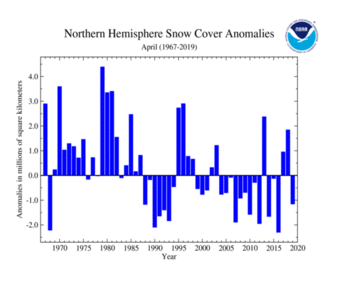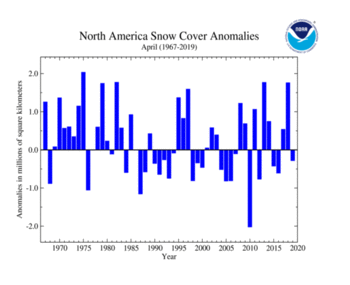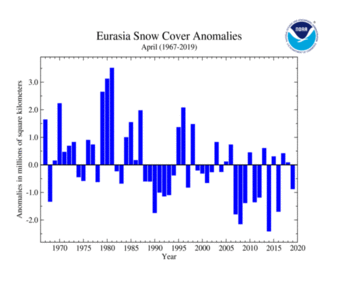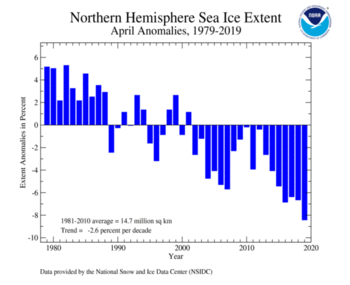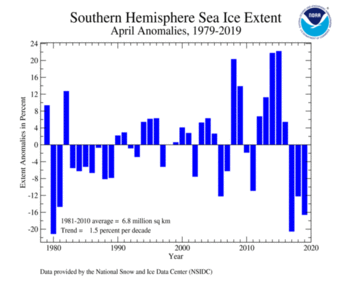NH Snow Cover Extent
| April 2019 | Snow Cover Extent | Anomaly 1991-2020 | Trend per decade | Rank (53 years) | Record | ||||||
|---|---|---|---|---|---|---|---|---|---|---|---|
| million km² | million mi² | million km² | million mi² | million km² | million mi² | Year(s) | million km² | million mi² | |||
| Northern Hemisphere | 29.06 | 11.22 | -0.87 | -0.34 | -0.42 | -0.16 | Largest | 42nd | 1979 | 34.61 | 13.36 |
| Smallest | 12th | 2016 | 27.91 | 10.78 | |||||||
| North America | 12.76 | 4.93 | -0.41 | -0.16 | -0.09 | -0.03 | Largest | 35th | 1975 | 15.08 | 5.82 |
| Smallest | 19th | 2010 | 11.02 | 4.25 | |||||||
| Eurasia | 16.30 | 6.29 | -0.46 | -0.18 | -0.33 | -0.13 | Largest | 41st | 1981 | 20.69 | 7.99 |
| Smallest | 13th | 2014 | 14.77 | 5.70 | |||||||
Data Source: Global Snow Laboratory, Rutgers University. Period of record: 1967–2019 (53 years)
The Northern Hemisphere snow cover extent (SCE) for April 2019 was below average at 29.06 million square km (11.22 square miles). This value is 1.16 million square km (450,000 square miles) less than the 1981–2010 average and the 12th smallest April SCE since records began in 1967. This was also the smallest April SCE since 2016. Warmer-than-average conditions across much of the Northern Hemisphere land could have contributed to the lower than average April snow cover extent. The most notable warm temperature departures from average were present across parts of Greenland, Scandinavia, and northern and central Asia, where temperatures were 3.0°C (5.6°F) above average or higher. Only Canada experienced below-average temperatures during April 2019.
The April North American SCE was 12.76 million square km (4.93 square miles), which is 280,000 square km (110,000 square miles) less than the 1981–2010 average. The April 2019 North American SCE was the smallest April SCE since 2016 and ranked as the 19th smallest in the 53-year record. Above-average snow cover was observed across parts of southeastern Canada and the northern Plains. Below-average April SCE was present across much of western Canada and across parts of the Rocky Mountains and the northwestern contiguous U.S. Canada's April SCE was below average, ranking as the 15th smallest April SCE in its 53-year record, while the contiguous U.S. had near-average SCE during April 2019 and the 22nd largest on record. Alaska had below-average conditions, resulting in the 19th smallest April SCE since records began in 1967.
The Eurasian SCE during April 2019 was 16.30 million square km (6.29 million square miles) or 870,000 square km (340,000 square miles) below the 1981–2010. This was the 13th smallest April SCE on record. Below-average SCE was observed across parts of southwestern Russia, northern Kazakhstan, northern Mongolia and northeastern China. Above-average conditions were present across parts of central Russia and south-central China.
Sea Ice Extent
| April 2019 | Sea Ice Extent | Anomaly 1991-2020 | Trend per decade | Rank (41 years) | Record | ||||
|---|---|---|---|---|---|---|---|---|---|
| million km² | million mi² | Year(s) | million km² | million mi² | |||||
| Northern Hemisphere | 13.43 | 5.19 | -6.22% | -2.65% | Largest | 41st | 1982 | 15.47 | 5.97 |
| Smallest | 1st | 2019 | 13.43 | 5.19 | |||||
| Southern Hemisphere | 5.72 | 2.21 | -17.70% | +1.44% | Largest | 39th | 2015 | 8.37 | 3.23 |
| Smallest | 3rd | 1980 | 5.40 | 2.08 | |||||
| Globe | 19.15 | 7.39 | -9.97% | -1.32% | Largest | 41st | 1982 | 23.19 | 8.95 |
| Smallest | 1st | 2019 | 19.15 | 7.39 | |||||
Data Source: National Snow and Ice Data Center (NSIDC). Period of record: 1979–2019 (41 years)
According to the National Snow and Ice Data Center (NSIDC), the Arctic (Northern Hemisphere) sea ice extent—which is measured from passive microwave instruments onboard NOAA satellites— averaged for April 2019 was 13.45 million square km (5.19 million square miles). This was 8.4% (1.24 million square km / 479,000 square miles) less than the 1981–2010 average and was the smallest April sea ice extent on record. The April 2019 Arctic sea ice extent had 230,000 square km (89,000 square miles) less sea ice than the previous record set in 2016. Rapid ice loss, of about 50%, through mid-month in the Sea of Okhotsk contributed to the record low extent. Additionally, sea ice extent was below average in the Baffin Bay, Barents Sea and Bering Sea. For a third consecutive month, the Bering Sea had near-record low sea ice extent at 66% below average, trailing behind April 2018 (76% below average).
April 2019 marks the third consecutive April that the Antarctic (Southern Hemisphere) sea ice extent was below average at 1.14 million square km (440,000 square miles) or 16.6% below the 1981–2010 average. This was the third smallest April extent in the 41-year record. Only Aprils 1980 (-21.2%) and 2017 (-20.6%) had less sea ice extent.
For further information on the Northern and Southern Hemisphere snow and ice conditions, please visit the NSIDC News page.
 NOAA's National Centers for Environmental Information
NOAA's National Centers for Environmental Information
